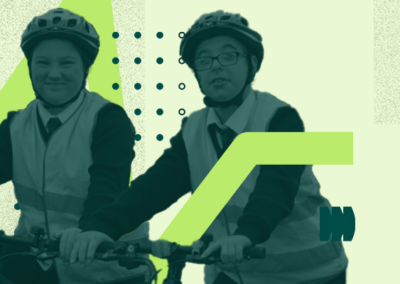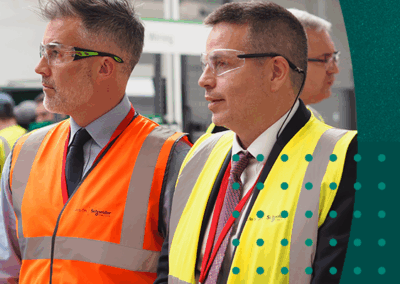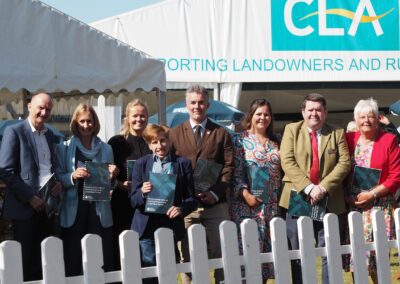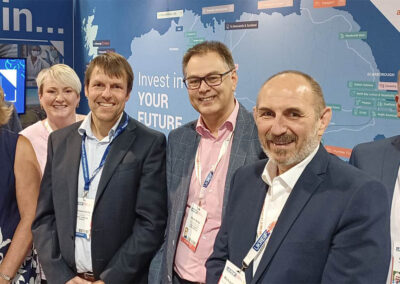The purpose of Vibrant and Sustainable High Streets Fund Phase Two is to rejuvenate and reanimate high streets across York and North Yorkshire through big, bold ideas.
Its key objectives are to strengthen the resilience of town centres, expand what they have to offer, and increase the number of events and activities that attract both residents and visitors.
Following the success of Phase One, nineteen projects have been approved.
These projects will inject new life into communities across the region, driving economic growth by broadening their appeal to both residents and visitors.
To see successful applications from Phase One, click here.
Invested
Projects supported
Locations
Successful Vibrant and Sustainable High Streets Fund Phase Two Applicants
19 projects led by local partnerships were successful in applying for funding from Phase Two.
Any uncommitted allocation of Phase Two funds will roll over into Phase Three.
Accessible Leyburn - A distinctly Dales market town for everybody
Lead Applicant
Leyburn Town Council
Project Description
Accessible Leyburn: Establishing a vibrant visitor and heritage hub with enhanced digital and in-person experiences, creating an inclusive, prosperous market town high street for all.
Grant Awarded
£117,523
Acomb Creative Community Festival
Lead Applicant
Art of Protest
Project Description
An annual festival to transform Acomb High Street into an open-air gallery and event centre, creating legacy and vibrancy through co-production, talent development and sustainability
Grant Awarded
£99,999
Colour and Light
Lead Applicant
York BID
Project Description
Colour & Light is a large-scale outdoor projection project, using the latest innovations in 3D projection mapping to bring York’s iconic buildings to life.
Grant Awarded
£93,228
Colourful Bentham
Lead Applicant
Bentham Town Council
Project Description
To transform Bentham’s Main Street into a vibrant, engaging and inclusive space through interactive art.
Grant Awarded
£50,000
Eggsplore York & Eggsplore Haxby
Lead Applicant
Schiewe Ceramics
Project Description
Eggsplore York/Haxby is a free public art trail and family event using ceramic Easter eggs to showcase local businesses and celebrate York’s hidden high streets.
Grant Awarded
£56,707
Eventure Knaresborough - Strengthening Free Events for Economic Impact
Lead Applicant
Chain Lane Community Hub
Project Description
A strategic initiative to invest in and diversify Knaresborough’s free events programme – enhancing existing offerings, fostering new partnerships, and driving sustained footfall and economic development.
Grant Awarded
£121,488
Experience Easingwold
Lead Applicant
Easingwold Town Council
Project Description
Experience Easingwold is for all ages and interests with activities throughout the year to stimulate business and generate fun and enjoyment.
Grant Awarded
£85,500
Flowergate and Beyond: Whitby's Artisan Quarter
Lead Applicant
Flash Company Arts CIC
Project Description
Flowergate and Beyond is a creative placemaking project transforming historic high streets into a vibrant, inclusive Artisan Quarter through culture, community, enterprise and collaboration.
Grant Awarded
£149,000
Kirkymoorside Town Brand and Town History Trail
Lead Applicant
Kirkbymoorside Community Support Group
Project Description
A project to create a new town brand and a history trail, boosting Kirkbymoorside’s identity, accessibility and appeal for residents, visitors and local businesses.
Grant Awarded
£35,662
Light up Haxby & Wigginton
Lead Applicant
Haxby & Wigginton Traders Ass.
Project Description
A schedule of community events to bring vibrancy to the High Street including Winter Lights, planters, community panto and new markets to Haxby all supported by the creation of a new website.
Grant Awarded
£46,000
Love Bishy Road
Lead Applicant
Bishopthorpe Road Traders Association
Project Description
A community-led project to revitalise Bishy Road through enhanced public realm, local events, and shared infrastructure – boosting footfall, engagement, and long-term sustainability.
Grant Awarded
£42,465
Marshall's Indie Revival
Lead Applicant
Yorkshire IN Business
Project Description
A vibrant independent retail space reviving Scarborough’s High Street, inspired by the heritage of the former Marshall & Snelgrove department store.
Grant Awarded
£100,384
Ryedale Gateway Project
Lead Applicant
You WIll Be CIC
Project Description
The Ryedale Gateway Project: Making Malton a creative hub for the community of Ryedale.
Grant Awarded
£46,900
Scarborough CHIP: Creative Highstreet Innovation Programme
Lead Applicant
Scarborough Studios CIO
Project Description
A 15 month, proactive intervention in the area around Scarborough Market Hall which will activate, support and accelerate businesses, attract new visitors and drive growth.
Grant Awarded
£149,750
Scarborough Streets
Lead Applicant
Stephen Joseph Theatre
Project Description
The Scarborough Streets programme is a year-round series of festivals and events to drive footfall and business to the high street area of Scarborough.
Grant Awarded
£149,479
Selby Sustainable High Street Customer Intelligence and Business Development Initiative
Lead Applicant
Up for Yorkshire
Project Description
Commission comprehensive market research to understand Selby high street visitors and charity shop customers, creating evidence base for targeted business development strategies.
Grant Awarded
£55,984
Spend Time in Stokesley
Lead Applicant
Stokesley Town Council
Project Description
A project to make Stokesley High Street an all year round destination of choice for both residents and visitors.
Grant Awarded
£50,040
The Next Chapter
Lead Applicant
Art of Protest
Project Description
Creating a vibrant open-aired gallery of storytelling complimenting Malton’s aesthetic as a historic town by celebrating local authors and artists through installations and events.
Grant Awarded
£99,950
York Fashion Week: A Permanent Residency
Lead Applicant
York Fashion Week
Project Description
York Fashion Week: A Permanent Residency is a year-round programme designed to boost York’s high-street through fashion events, creative showcases, retail support and industry collaboration.
Grant Awarded
£149,020
Latest Updates
15.10.25 Successful Applicants Announced For Phase Two of Mayor’s Vibrant and Sustainable High Street Fund
31.07.25 Phase Two applications closed.
27.05.25 Successful Applicants Announced For Phase One of Mayor’s High Street Fund
21.03.25 Phase One applications closed. In total, 42 applications were received from across York and North Yorkshire.
25.02.25 Spark:York founder backs High Street Fund to boost city – York Press
About the Programme
High Streets across the UK are facing significant challenges. Here in York and North Yorkshire they have long been part of the social, economic and cultural fabric – driving the local economy, providing jobs, supporting small businesses, serving as social hubs and contributing to a sense of place.
However, over a number of years many have been in decline, with dramatic changes caused by multiple factors, including the Covid-19 pandemic, out-of-town retail facilities, home-working, online shopping and increased cost-of-living. The impact of which has been reduced footfall, reduction in investment and an uncertainty in the future of our High Streets.
Even though High Street decline is often caused by a common set of factors, no two locality areas are the same. In York and North Yorkshire, we recognise our differences and seek to use these differences to our advantage when considering solutions to improving the vibrancy and sustainability of our High Streets.
Key Objectives and Outcomes
- Support town centres and high streets to improve their resilience and expand their local offer.
- Increase the number of events and activities attracting people to use their local town centres and high streets.
- Support activities aimed at reducing the number of vacant units (where it’s an issue) and increase footfall (where it is currently low).
- Improve perceptions of town centres and high streets within local communities and for visitors.
Vibrant and Sustainable High Streets Fund Phase Three
Phase Three of the Vibrant and Sustainable High Street Fund will launch in Autumn 2025.
The fund will support ‘Local Partnerships’. Individual businesses and/or community organisations are encouraged to come together as a collective to form a ‘local partnership’ with a shared goal that represents the interests of the High Street. Local partnerships may be a formally constituted organisation or an informal partnership.
Our High Streets Team and the Local Authority Business Support Teams are working across the region to offer advice and support. If you would like to find out more about the fund or discuss ideas for your local High Street with us, please get in touch.
Find the High Street Coordinator for your area here.
Find your Local Authority Business Advisors for York and North Yorkshire.
Useful Documents
- York and North Yorkshire Combined Authority – Economic Framework
- York and North Yorkshire Combined Authority – Mayor’s Vision
- York and North Yorkshire Routemap to Carbon Negative – (Summary Document)
- Guide to Developing the Project Business Case – Chapter 2 outlines HM Treasury’s 5 Cases Methodology
- UK subsidy control regime: statutory guidance – GOV.UK
- FSB | The Future of the High Street
- 25 Vital and Viable Priorities | Institute of Place Management
- Taking Back the High Street – Power to Change
- High Streets and Town Centres in 2030 – Report Summary – Housing, Communities and Local Government Committee
- The High Street Report – Ministry of Housing, Communities & Local Government (2018 to 2021)
Stay Up To Date
You can stay-up-to-date with the latest information on these funds and other York and North Yorkshire Combined Authority news by signing up to our newsletter.
Get in touch
If you have any further questions, please fill in the following form and a member of the team will be in touch.











